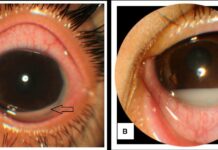Running into a swarm of flies doesn’t sound a big deal, one ‘shoo’ and the flies scare away!
This isn’t the case every time!
Before ‘shoo-ing,’ there are a few split seconds, and sometimes those seconds are enough for the transmission of infection.
A retired medical anthropologist and public health researcher from Nebraska, Dianne Travers-Gustafson, was unfortunate enough to encounter a swarm of small flies while jogging along a steep trail in a Carmel Valley in California. That regional park is populated by the livestock and horses that belong to the local residents.
The 68-year-old woman, Dianne, had encountered the flies in the February of 2018, and in early March, she felt irritation in her right eye, which she rinsed with running tap water. To inspect, she closely looked at her right eye with a penlight in the magnifying mirror. It is here when she saw translucent, glittering motile objects. While irrigating and flushing here eye, she recovered a 0.5 inch long, translucent roundworm from her right eye. She noticed another similar worm, which she manually extracted from her right eye. The worms were motile.
She said:
“We live on a farm, and we’ve had cattle, so it’s not that we don’t have flies… But I’d never seen anything quite like this.”
A third nematode was manually removed by the ophthalmologist in California when she consulted the ophthalmologist the next day. The patient was advised to irrigate the eye continuously with distilled water and manually remove nematodes if any. The ophthalmologist also prescribed topical Tobrex, i.e., tobramycin, with chlorambutanol preservative, to avoid secondary bacterial infection.
The irritation continued, and the patient returned to Nebraska, where she consulted another ophthalmologist. This time she was diagnosed with mild bilateral papillary conjunctivitis, but no worm was recovered or seen even after a thorough ocular examination.
Not much later, a fourth worm was removed by the patient while irrigating her eyes.
Treatment with tobramycin was continued for a month with irrigation of eyes, which was continued till 2 weeks after the discontinuation of tobramycin. Conjunctivitis was resolved, and no more worms were found.
Travers-Gustafson was the second person ever reported to be infected by the cattle eye worm (Thelazia gulosa).
Expressing her thoughts, she said:
“My first actual thought was, ‘Wow, fascinating. This is interesting. What in the world is going on here?’ Then a second later, I was like, ‘Yikes, I’m a host.”
She must have been infected by one of the flies; a few seconds are enough for the fly to infect the eye with the larva. These flies drink the tears of animals like horses and cattle and hardly infect humans explaining why Travers-Gustafson’s condition is of a rare occurrence. She recovered without any long term sequelae.
Reference
Richard S Bradbury, Dianne Travers Gustafson, Sarah G H Sapp, Mark Fox, Marcos de Almeida, Michelle Boyce, Peter Iwen, Vicki Herrera, Mackevin Ndubuisi, Henry S Bishop, A Second Case of Human Conjunctival Infestation With Thelazia gulosa and a Review of T. gulosa in North America, Clinical Infectious Diseases, Volume 70, Issue 3, 1 February 2020, Pages 518–520, https://doi.org/10.1093/cid/ciz469




